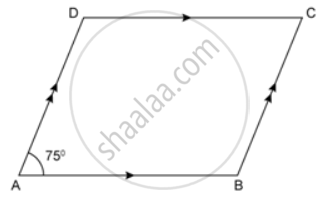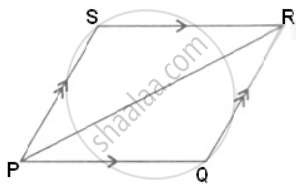Advertisements
Advertisements
Question
In a parallelogram ABCD ∠C = 98°. Find ∠A and ∠B.
Solution

ABCD is a parallelogram
∠C = 98°
∴ ∠A = ∠C = 98° ....(opposite angles of a parallelogram are equal)
∠A + ∠B +∠C + ∠D = 360° ....(Sum of all angles of a quadrilateral = 360°)
98° + ∠B + 98° + ∠D = 360°
∠B + 196 + ∠D = 360°
∠B + ∠D = 360° - 196°
∠B +∠D = 164°
But ∠B = ∠D ....(opposite angles of a parallelogram are equal)
⇒ 2∠B = 164°
⇒ ∠B = 82° = ∠D
Therefore,
∠B = 82°, ∠A = 98°.
APPEARS IN
RELATED QUESTIONS
In case of a parallelogram
prove that:
(i) The bisectors of any two adjacent angles intersect at 90o.
(ii) The bisectors of the opposite angles are parallel to each other.
In the given figure, AP is the bisector of ∠A and CQ is the bisector of ∠C of parallelogram ABCD. 
Prove that APCQ is a parallelogram.
In the following figure, ABCD is a parallelogram. 
Prove that:
(i) AP bisects angle A.
(ii) BP bisects angle B
(iii) ∠DAP + ∠BCP = ∠APB
In the following figures, find the remaining angles of the parallelogram
In the following figures, find the remaining angles of the parallelogram
The consecutive angles of a parallelogram are in the ratio 3:6. Calculate the measures of all the angles of the parallelogram.
In the given figure, ABCD is a parallelogram, find the values of x and y.
PQR is a triangle formed by the adjacent sides PQ and QR and diagonal PR of a parallelogram PQRS. If in ΔPQR, ∠P : ∠Q : ∠R = 3 : 8 : 4, Calculate the measures of all the angles of parallelogram PQRS.
Opposite angles of a quadrilateral ABCD are equal. If AB = 4 cm, determine CD.
If PQRS is a parallelogram, then ∠P – ∠R is equal to ______.
